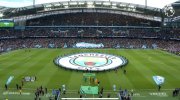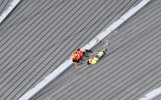You are using an out of date browser. It may not display this or other websites correctly.
You should upgrade or use an alternative browser.
You should upgrade or use an alternative browser.
North Stand Construction Discussion
- Thread starter awest
- Start date
The hotel gable on the claw side - they have gone with almost a shaftwall type build-up from the inside, and then clad it from the outside before the screens go on.
On the side gable towards the road, they are building it in blockwork from the inside (with whatever lining yet to come).
Loosely intrigued by the difference.
On the side gable towards the road, they are building it in blockwork from the inside (with whatever lining yet to come).
Loosely intrigued by the difference.
Last edited:
Bournemouth Blue
Well-Known Member
- Joined
- 21 Mar 2015
- Messages
- 3,254
Filmed today
The video is 15 minutes long.
The video is a little bit shaky
There's no commentary, just construction noises.
Watch in HD, white cog.
Enjoy.
Thanks for this, interesting to see it from ground level, looks like a mighty structure
Thanks for this, interesting to see it from ground level, looks like a mighty structure
Yeah, it gives another perspective of the stand from ground level.
I'll do another video again in the future.
I've noticed a few things I could have done better, especially on the left side of the stand, where the video was moving too much. By then my arm started hurting a bit, so I just wanted to finish the video as fast as I could. I'll spend less time on the dog leg of the hotel next time, which was mainly the hoardings, and the hotel behind the hoardings.
Penders1957
Well-Known Member
- Joined
- 14 Jul 2024
- Messages
- 452
- Team supported
- Man city
If I remember correctly weren’t the 2 extra sections on the third tier only added at the very last minute, something to do with the steel structure ?? Maybe still time ??When complete, it will be over 62k. Just. If including the suites looking onto the pitch within the hotel, that is.
Gordyola
Well-Known Member
The sightlines wouldn’t have been good due to the disparity between the three tiers and the two tiers Probably could have got a few more in but more than likely not worth the costI’ve wondered why the didn’t extend those, as they did when the South Stand was extended.
Would add another
I’ve wondered that, it would also add around 260 seats to capacity, pushing it well over 62k.
Also no space for the screens


HelloCity
Well-Known Member
The sightlines wouldn’t have been good due to the disparity between the three tiers and the two tiers Probably could have got a few more in but more than likely not worth the cost
Also no space for the screens
View attachment 154366View attachment 154367
The extended end blocks are actually built under the original roof and are within the original structure. The view would be no different if they were built at the North Stand end vs where they have been built at the South Stand end.
The screen positioning at the North Stand end also allow room for that addition block to be built.


Went to the Etihad this afternoon, done a good video lots happening, then decided to bring the drone back and do another one, lost signal and managed to regain control before it went into a crane, forgot to press record on that video and also my microphone didn't record. Had a bad day at the office, but got the footage coming out in the next 30mins.
remember arthur mann
Well-Known Member
Went to the Etihad this afternoon, done a good video lots happening, then decided to bring the drone back and do another one, lost signal and managed to regain control before it went into a crane, forgot to press record on that video and also my microphone didn't record. Had a bad day at the office, but got the footage coming out in the next 30mins.
HelloCity
Well-Known Member
SAMtheMANc
Member
- Joined
- 28 Sep 2017
- Messages
- 19
I wonder if they went to Wembley?
The foldable Kalzip aluminium was being fabricated on-site today, as seen in the video, and is going to be placed on the hotel roof.
Kalzip foldable aluminium sets new standards for visually attractive façade elevations and meets the highest structural and design requirements from planning to implementation. The unmistakable metallic surfaces minimise glare and reflections and convey a discreet, prestigious building character even on large surfaces. Kalzip foldable aluminium can be processed for metal wall cladding using conventional roofing techniques. The most frequently chosen design is the angled standing seam or a diamond or shingle covering on a ventilated formwork.

 www.kalzip.com
www.kalzip.com
Kalzip foldable aluminium sets new standards for visually attractive façade elevations and meets the highest structural and design requirements from planning to implementation. The unmistakable metallic surfaces minimise glare and reflections and convey a discreet, prestigious building character even on large surfaces. Kalzip foldable aluminium can be processed for metal wall cladding using conventional roofing techniques. The most frequently chosen design is the angled standing seam or a diamond or shingle covering on a ventilated formwork.

Traditional metal facade: Façade made of foldable aluminium
Advantages & structure of Kalzip foldable aluminium cladding. Double-skin, rear-ventilated façade construction with Kalzip sheet metal façades
Will there only be two sets of 'exits' from the seating in the new tier (the ones in the existing NS2 and the ones lower down in the extended stand)? If so, would it not have been possible to incorporate another exit higher up? Strikes me that one of the reasons for early leavers is how long it takes to get down the stairs from near the back of SS3, say, to the exits if you wait till full-time. More exits = less queues = less need to beat the 'traffic' ?
The foldable Kalzip aluminium was being fabricated on-site today, as seen in the video, and is going to be placed on the hotel roof.
Kalzip foldable aluminium sets new standards for visually attractive façade elevations and meets the highest structural and design requirements from planning to implementation. The unmistakable metallic surfaces minimise glare and reflections and convey a discreet, prestigious building character even on large surfaces. Kalzip foldable aluminium can be processed for metal wall cladding using conventional roofing techniques. The most frequently chosen design is the angled standing seam or a diamond or shingle covering on a ventilated formwork.

Traditional metal facade: Façade made of foldable aluminium
Advantages & structure of Kalzip foldable aluminium cladding. Double-skin, rear-ventilated façade construction with Kalzip sheet metal façadeswww.kalzip.com
Interesting stuff jrb cheers
Tevez City
Well-Known Member
- Joined
- 9 May 2010
- Messages
- 15,106
remember arthur mann
Well-Known Member
The foldable Kalzip aluminium was being fabricated on-site today, as seen in the video, and is going to be placed on the hotel roof.
Kalzip foldable aluminium sets new standards for visually attractive façade elevations and meets the highest structural and design requirements from planning to implementation. The unmistakable metallic surfaces minimise glare and reflections and convey a discreet, prestigious building character even on large surfaces. Kalzip foldable aluminium can be processed for metal wall cladding using conventional roofing techniques. The most frequently chosen design is the angled standing seam or a diamond or shingle covering on a ventilated formwork.

Traditional metal facade: Façade made of foldable aluminium
Advantages & structure of Kalzip foldable aluminium cladding. Double-skin, rear-ventilated façade construction with Kalzip sheet metal façadeswww.kalzip.com
Manufactured on site saves a whole lot of transportation cost but is the material on the coil pre anodised?
Just checked it out, it can be done.
Why Anodize Aluminum Coils?
- Corrosion Resistance:
Anodizing creates a protective oxide layer on the surface of aluminum, significantly increasing its resistance to corrosion, particularly in harsh environments like marine applications.
- Durability:
The oxide layer is hard and wear-resistant, making anodized aluminum suitable for applications where durability is crucial.
- Aesthetics:
Anodization can be used to create a wide range of colors and finishes, enhancing the appearance of aluminum products.
- Improved Adhesion:
The anodized surface can improve the adhesion of paints, coatings, and adhesives, making it suitable for various applications.
- Continuous Anodising:
Large-scale anodization of coils is typically done using a continuous process, where the coil is passed through an electrolytic bath, allowing for efficient and consistent coating.
- Material Compatibility:
Most technically relevant aluminum alloys can be anodized, although the specific alloy can affect the final color.
- Dimensional Range:
Continuous anodising lines can handle coils with a wide range of thicknesses (0.5mm to 3.5mm) and widths (up to 2000mm).
- Film Thickness:
The thickness of the anodized film can be tailored to suit the specific application, ranging from 1 micron to 25 microns.
- Aloxide: Claims to be the world's largest continuous anodizer of flat rolled aluminum products in coil form.
- SPA Aluminium: Offers in-house anodising for extrusions and sheets, including a "free issue" service for customers.
- Hollinbrow Precision Products UK: Provides anodized aluminum slit coils and other dimensions upon request.
Last edited:
AI says stuff, but it is just stuff said.Manufactured on site saves a whole lot of transportation cost but is the material on the coil pre anodised?
Just checked it out, it can be done.
Why Anodize Aluminum Coils?
How it's done:
- Corrosion Resistance:
Anodizing creates a protective oxide layer on the surface of aluminum, significantly increasing its resistance to corrosion, particularly in harsh environments like marine applications.
- Durability:
The oxide layer is hard and wear-resistant, making anodized aluminum suitable for applications where durability is crucial.
- Aesthetics:
Anodization can be used to create a wide range of colors and finishes, enhancing the appearance of aluminum products.
- Improved Adhesion:
The anodized surface can improve the adhesion of paints, coatings, and adhesives, making it suitable for various applications.
Examples of Manufacturers:
- Continuous Anodising:
Large-scale anodization of coils is typically done using a continuous process, where the coil is passed through an electrolytic bath, allowing for efficient and consistent coating.
- Material Compatibility:
Most technically relevant aluminum alloys can be anodized, although the specific alloy can affect the final color.
- Dimensional Range:
Continuous anodising lines can handle coils with a wide range of thicknesses (0.5mm to 3.5mm) and widths (up to 2000mm).
- Film Thickness:
The thickness of the anodized film can be tailored to suit the specific application, ranging from 1 micron to 25 microns.
- Aloxide: Claims to be the world's largest continuous anodizer of flat rolled aluminum products in coil form.
- SPA Aluminium: Offers in-house anodising for extrusions and sheets, including a "free issue" service for customers.
- Hollinbrow Precision Products UK: Provides anodized aluminum slit coils and other dimensions upon request.
I dont think that is in any way conclusive.
I think AI as a go to default in search engines is terrible fwiw.
The shoehorn and screwdriver I made in metalwork in 1970 has never rusted…Manufactured on site saves a whole lot of transportation cost but is the material on the coil pre anodised?
Just checked it out, it can be done.
Why Anodize Aluminum Coils?
How it's done:
- Corrosion Resistance:
Anodizing creates a protective oxide layer on the surface of aluminum, significantly increasing its resistance to corrosion, particularly in harsh environments like marine applications.
- Durability:
The oxide layer is hard and wear-resistant, making anodized aluminum suitable for applications where durability is crucial.
- Aesthetics:
Anodization can be used to create a wide range of colors and finishes, enhancing the appearance of aluminum products.
- Improved Adhesion:
The anodized surface can improve the adhesion of paints, coatings, and adhesives, making it suitable for various applications.
Examples of Manufacturers:
- Continuous Anodising:
Large-scale anodization of coils is typically done using a continuous process, where the coil is passed through an electrolytic bath, allowing for efficient and consistent coating.
- Material Compatibility:
Most technically relevant aluminum alloys can be anodized, although the specific alloy can affect the final color.
- Dimensional Range:
Continuous anodising lines can handle coils with a wide range of thicknesses (0.5mm to 3.5mm) and widths (up to 2000mm).
- Film Thickness:
The thickness of the anodized film can be tailored to suit the specific application, ranging from 1 micron to 25 microns.
- Aloxide: Claims to be the world's largest continuous anodizer of flat rolled aluminum products in coil form.
- SPA Aluminium: Offers in-house anodising for extrusions and sheets, including a "free issue" service for customers.
- Hollinbrow Precision Products UK: Provides anodized aluminum slit coils and other dimensions upon request.

